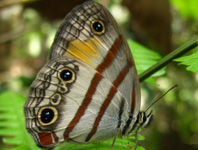Abstract
Serranochromis robustus robustus from Lake Malaŵi and Serranochromis robustus jallae from Zambia were compared using morphological data. We re-elevated S. robustus jallae to species based on the following. Serranochromis robustus generally has a longer lower jaw (50.7–59.6% HL) than S. jallae (49.2–52.7% HL). Serranochromis robustus is not as deep-bodied as S. jallae as evidenced by the distance between the posterior insertion of the dorsal fin and the posterior insertion of the anal fin (13.4–15.1% SL in S. robustus vs. 14.9–18.4% SL in S. jallae). Additionally, S. robustus has a narrower least caudal peduncle depth (10.9–12.8% SL) than S. jallae (11.3–14.2% SL); the least caudal peduncle depth of all S. robustus was less than 12.8% SL while, except for the smallest specimen of S. jallae (88.1 mm SL), the least caudal peduncle depth was greater than 13.2% SL. Adults in breeding color of Serranochromis robustus are blue/green laterally, while adults in breeding color of S. jallae are yellow/green laterally. The marginal bands on the dorsal and caudal fins of S. jallae are bright orange in specimens from the Okavango River system and creamy yellow in Upper Zambezi specimens. In S. robustus, there is a yellow marginal band on the dorsal fin.
References
Bertram, C.K., Borley, H.J. & Trewavas, E. (1942) Report on the fish and fisheries of Lake Nyasa 1945–1947. Crown Agents, London, 181 pp.
Bills, R., Boycott, R., Fakudze, M., Khumalo, N., Msibi, J., Scott, L., Terry, S. & Tweddle, D. (2004) Fish and fisheries survey of Swaziland (2002–2003), Final Report—July 2004. SAIAB Investigational Report, 70, 1–166 pp.
Bookstein, F., Chernoff, B., Elder, R., Humphries, J., Smith, G., & Strauss, R. (1985) Morphometrics in evolutionary biology. The Academy of Natural Sciences of Philadelphia Special Publication 15. The Academy of Natural Sciences of Philadelphia, Philadelphia, 277 pp.
Bell-Cross, G. & Minshull, J.L. (1988) The Fishes of Zimbabwe. Trustees of the National Museums and Monuments of Zimbabwe, Harare, 294 pp.
Boulenger, G.A. (1896) Liste des poisons recueillis par le R. P. Louis Jalla a Kazungula, Haut Zambese. Bollettino dei Musei di Zoologia ed Anatomia, 11 (260), 1–2.
Boulenger, G.A. (1899) A revision of the African and Syrian fishes of the family Cichlidae, Part II, Proceedings of the Zoological Society of London, 1899, 98–143.
Boulenger, G.A. (1911) On a collection of fishes from the Lake Ngami basin, Bechuanaland Transactions of the Zoological Society of London, 18, 399–418.
https://doi.org/10.1111/j.1469-7998.1907.tb07828.x
De Moor, I.J. & Bruton, M.N. (1988) Atlas of alien and translocated indigenous aquatic animals of southern Africa. South African National Scientific Programmes Report, 144, 78–133
Gilchrist, J.D.F. & Thompson, W.W. (1917) The freshwater fishes of South Africa (continued). Annuals of the South African Museum, 16, 251–293.
https://doi.org/10.5962/bhl.part.5074
Günther, A. (1864) Report on a collection of reptiles and fishes made by Dr. Kirk in the Zambesi and Nyassa regions. Proceedings of the Zoological Society of London, 1864 (Pt 2), 303–314, pls. 26–27.
Humphries, J.M., Bookstein, F.L., Chernoff, B., Smith, G.R., Elder, R.L. & Poss, S.G. (1981) Multivariate discrimination by shape in relation to size. Systematic Zoology, 30, 291–308.
https://doi.org/10.2307/2413251
Jackson, P.B.N. (1961) Check list of the fishes of Nyassaland. Occasional Papers of the Natural Museum of Southern Rhodesia, Natural Sciences, 3, 535–561.
Joyce, C.A., Lunt, D.H., Bills, R., Turner, G.F., Katongo, C., Duftner, N., Sturmbauer, C. & Seehausen, O. (2005) An extant cichlid fish radiation emerged in an extinct Pleistocene Lake. Nature, 435, 90–93.
https://doi.org/10.1038/nature03489
Jubb, R.A. (1961) An illustrated guide to the freshwater fishes of the Zambezi river, Lake Kariba, Pungwe, Sabi, Lundi, and Limpopo rivers. Stuart Manning, Bulawayo, 170 pp.
Jubb, R.A. (1967a) A new Serranochromis (Pisces, Cichlidae) from the Incomati River system, eastern Transvaal, South Africa. Annals of the Cape Provincial Museums, Natural History, 6 (5), 55–62.
Jubb, R.A. (1967b) Freshwater Fishes of Southern Africa. AA Balkema, Cape Town and Amsterdam. 248 pp.
Lowe, R.H. (1952) Report on the Tilapia and other Fish and Fisheries of Lake Nyasa 1945–47. HMSO, Colonial Office Fishery Publications 1 (2). HMSO, Colonial Office Fishery London, 126 pp.
Marshall, B. (2011) The Fishes of Zimbabwe and their Biology. Smithiana Monograph 3, 290 pp.
Poll, M. (1967) Contribution a la faune ichthyologique de l’Angola. Museu do Dundo, Publicacoes Culturais, 75, 1–381.
Regan, C.T. (1920) The classification of the fishes of the family Cichlidae. I. The Tanganyika genera. Annuals of the Magazine of Natural History, Series 9, 5 (25), 33–53.
https://doi.org/10.1080/00222932008632340
Regan, C.T. (1922) The cichlid fishes of Lake Nyasa. Proceedings of the Zoological Society of London, 1921, 675–727.
https://doi.org/10.1111/j.1096-3642.1921.tb03287.x
Skelton, P.H. (2001) Freshwater Fishes of Southern Africa. Struik Publishers, Cape Town, 395 pp.
Stauffer Jr., J.R. (1994) A new species of Iodotropheus (Teleostei: Cichlidae) from Lake Malaŵi, Africa. Ichthylogical Exploration of Freshwaters, 5, 331–344.
Stauffer Jr., J.R. & Hert, E. (1992) Pseudotropheuscallainos, a new species of mbuna (Cichlidae) with analyses associated with two intralacustine transplantations in Lake Malaŵi, Africa. Ichthyological Exploration of Freshwaters, 3, 253–264.
Stauffer Jr., J.R. & Konings, A.F. (2006) Review of Copadichromis (Telostei: Cichlidae) with the description of a new genus and six new species. Ichthyological Exploration of Freshwaters, 17, 9–42.
Thorstad, E.B., Hay, C.J., Næsje, T.F., Chanda, B. & Økland, F. (2005) Movements and habitat utilization of nembwe, Serranochromis robustus (Günther, 1864), in the Upper Zambezi River. African Zoology, 40, 253–259.
https://doi.org/10.1080/15627020.2005.11407324
Trewavas, E. (1935) A synopsis of the cichlid fishes of Lake Nyasa. Annals and Magazine of Natural History, Series 10, 16 (91), 65–118.
https://doi.org/10.1080/00222933508655026
Trewavas, E. (1964) A revision of the genus Serranochromis Regan (Pisces, Cichlidae). Musee Royal de l’Afrique Centrale, Tervuren, Annales, Series in-8º, Sciences Zoologique, 125, 1–58.
Winemiller, K.O. (1991) Comparative ecology of Serranochromis species (Teleostei: Cichlidae) in the Upper Zambezi River floodplain. Journal of Fish Biology, 39, 617–639.
https://doi.org/10.1111/j.1095-8649.1991.tb04393.x
Van der Waal, B.C.W. (1985) Aspects of the Biology of larger fish species of Lake Liambezi, Caprivi SWA. Madoqua, 14 (2), 101–144.


